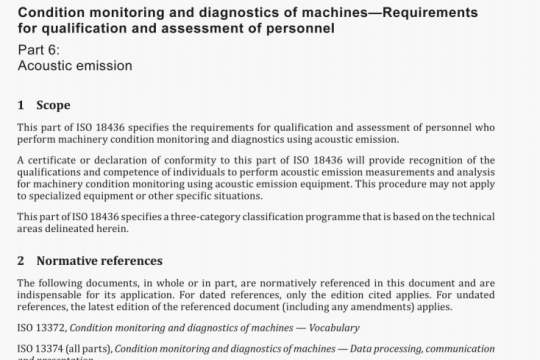ISO 14346:2013 pdf free
ISO 14346:2013 pdf free.Static design procedure for welded hollow-section joints一Recommendations
The following conditions are requirements for hollow-section joints.
一Steel grades shall be according to Clause 6.
一Hollow-section joint types shall be according to Clause 7.
一The nominal wall thickness of hollow sections shall be limited to a minimum of 1,5 mm.
一For hollow-section chords with a wall thickness greater than 25 mm, the steel shall meet adequate through thickness properties as specified in ISO 630.
一The ends of members that meet at a joint shall be prepared in such a way that their cross-sectional shape is not modified. Flattened end joints and cropped end joints are not covered in this International Standard.
一Where brace members are welded to a chord member, the included angle between brace and chord should be at least 30° This is to ensure that proper welds can be made. For angles less than 30, confirmation that sound welds can be made should be obtained from the fabricator.
一In gap-type joints, to ensure that there is adequate clearance to form satisfactory welds, the gap between adjacent brace members shall not be less than the sum of the brace member thicknesses (t1 + t2).
一In overlap-type joints, the overlap shall be large enough to ensure that the interconnection of the brace members is sufficient for adequate shear transfer from one brace to the other. In any case, the overlap ratio (defined in Clause 4) shall be at least 25 %.
一Where overlapping brace members are of different widths, the narrower member shall overlap the wider.
一In gap and overlap K-joints, the noding eccentricity, e, shown in Figure 1 h) and i), produces a primary bending moment which requires consideration when designing truss members.
一In gap and overlap K-joints, restrictions are placed on the noding eccentricity, e, shown in Figure 1 h) and i]. Within the specified limits (e≤0,25do or e≤0,25ho), the bending moment due to this eccentricity is taken into account, for its effect on joint resistance, in the Qf term (a function to account for chord stress at the connection face). If the noding eccentricty, e, exceeds the limits in the previous sentence, the effect of the resulting bending moment on the joint resistance shall be taken into account by distributing part of the total eccentricity moment to the brace members. (In such cases, the joint resistance shall then be determined by checking the interaction of brace axial load and brace bending moment.)ISO 14346 pdf download.




